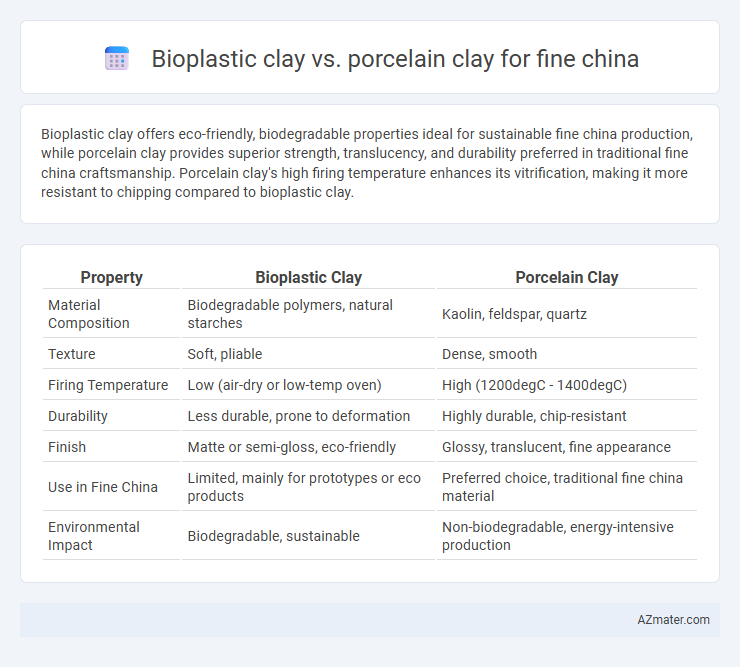Bioplastic clay offers eco-friendly, biodegradable properties ideal for sustainable fine china production, while porcelain clay provides superior strength, translucency, and durability preferred in traditional fine china craftsmanship. Porcelain clay's high firing temperature enhances its vitrification, making it more resistant to chipping compared to bioplastic clay.
Table of Comparison
| Property | Bioplastic Clay | Porcelain Clay |
|---|---|---|
| Material Composition | Biodegradable polymers, natural starches | Kaolin, feldspar, quartz |
| Texture | Soft, pliable | Dense, smooth |
| Firing Temperature | Low (air-dry or low-temp oven) | High (1200degC - 1400degC) |
| Durability | Less durable, prone to deformation | Highly durable, chip-resistant |
| Finish | Matte or semi-gloss, eco-friendly | Glossy, translucent, fine appearance |
| Use in Fine China | Limited, mainly for prototypes or eco products | Preferred choice, traditional fine china material |
| Environmental Impact | Biodegradable, sustainable | Non-biodegradable, energy-intensive production |
Introduction to Fine China Materials
Fine china materials prominently include bioplastic clay and porcelain clay, each offering distinct properties for crafting delicate ceramics. Porcelain clay, composed mainly of kaolin, feldspar, and quartz, provides exceptional translucency, strength, and high-temperature durability essential for fine china's elegance and longevity. Bioplastic clay, a more recent innovation, incorporates plant-based polymers that enhance moldability and environmental sustainability but currently lacks the high-fired strength and translucency characteristic of traditional porcelain used in fine china production.
Defining Bioplastic Clay
Bioplastic clay is a versatile, eco-friendly material derived from renewable plant-based sources, offering a lightweight and flexible alternative to traditional clays. Unlike porcelain clay, known for its high firing temperature and durability, bioplastic clay does not require kiln firing and is ideal for decorative, non-functional fine china pieces. This sustainable option emphasizes biodegradability and ease of manipulation while maintaining a smooth finish suitable for detailed craftsmanship.
Overview of Porcelain Clay
Porcelain clay, known for its high kaolin content, offers exceptional whiteness, translucency, and durability, making it ideal for fine china production. It fires at high temperatures around 1,200-1,400degC, resulting in a vitrified, non-porous surface that resists chipping and enhances elegance. Unlike bioplastic clay, porcelain clay requires expert craftsmanship and precise kiln control to achieve its characteristic strength and delicate aesthetic.
Material Composition: Bioplastic vs Porcelain
Bioplastic clay is composed primarily of renewable plant-based polymers such as cellulose and starch, offering flexibility and eco-friendly attributes, whereas porcelain clay contains kaolin, feldspar, and quartz, providing a dense and vitrified finish ideal for fine china. The molecular structure of bioplastic clay allows for lightweight and malleable applications, contrasting with porcelain's high firing temperature (approximately 1200-1400degC) that creates a durable, translucent surface. Understanding these material compositions highlights their differing properties in terms of durability, aesthetics, and environmental impact for fine china production.
Workability and Handling Differences
Bioplastic clay offers superior workability compared to porcelain clay due to its higher plasticity and flexibility, allowing easier shaping and intricate detailing for fine china. Porcelain clay, while less plastic, provides a smoother, finer texture but requires careful handling to prevent cracking or warping during molding and drying. The differences in moisture content and particle size between these clays significantly impact their handling, with bioplastic clay being more forgiving for detailed work and porcelain demanding more precision and experience.
Firing Temperatures and Processes
Bioplastic clay typically fires at lower temperatures between 1,650degF and 1,830degF (900degC to 1,000degC), allowing for quicker, energy-efficient kiln processes ideal for decorative or less durable fine china pieces. Porcelain clay requires much higher firing temperatures, ranging from 2,300degF to 2,600degF (1,260degC to 1,430degC), resulting in a vitrified, translucent, and highly durable surface essential for traditional fine china quality. The slower, high-temperature firing of porcelain also ensures superior strength and chip resistance compared to the relatively softer finish of bioplastic clay.
Aesthetic Outcomes: Texture and Finish
Bioplastic clay offers a smooth, non-porous texture that allows for vibrant colors and detailed sculpting, ideal for fine china with a modern aesthetic. Porcelain clay provides a delicate, translucent finish with a refined surface that enhances traditional elegance and subtle glaze effects. The choice between bioplastic and porcelain clay significantly influences the tactile experience and visual appeal of fine china pieces.
Durability and Longevity Comparison
Bioplastic clay offers moderate durability with flexibility that resists cracking during shaping, but it generally lacks the long-term strength and chip resistance required for fine china. Porcelain clay, composed mainly of kaolin, provides exceptional longevity due to its high firing temperature, which results in a dense, vitrified surface highly resistant to wear, scratches, and thermal shock. For fine china, porcelain clay remains the superior choice in durability and lifespan, ensuring pieces withstand frequent use and maintain their pristine appearance over decades.
Sustainability and Environmental Impact
Bioplastic clay, made from renewable plant-based materials, offers significant sustainability advantages over traditional porcelain clay by reducing reliance on non-renewable resources and lowering carbon emissions during production. Porcelain clay, primarily composed of kaolin and other minerals, involves energy-intensive mining and firing processes that contribute to environmental degradation and higher greenhouse gas footprints. Choosing bioplastic clay for fine china aligns with eco-friendly manufacturing practices, promoting biodegradability and reducing landfill waste compared to conventional porcelain.
Choosing the Right Clay for Fine China
Choosing the right clay for fine china depends on the desired properties and end use; porcelain clay offers a smooth, white, and translucent finish ideal for delicate, high-quality fine china, while bioplastic clay provides eco-friendly benefits and flexibility but lacks the same translucency and strength. Porcelain clay's high firing temperature ensures durability and a refined surface suitable for intricate designs, whereas bioplastic clay excels in sustainable production with lower environmental impact but may not achieve the same professional-grade finish. Understanding these distinctions helps artisans select the optimal material for both aesthetic appeal and functional performance in fine china creation.

Infographic: Bioplastic clay vs Porcelain clay for Fine china
 azmater.com
azmater.com